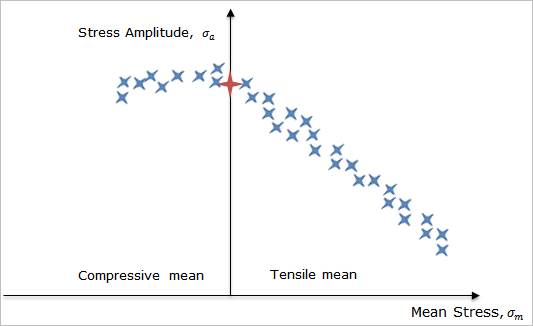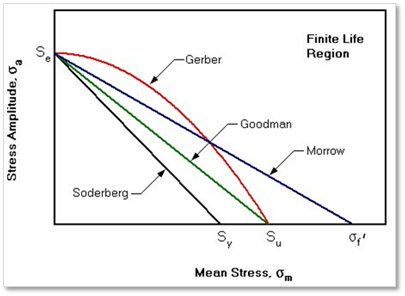14.3.3. Stress Life Criteria
Manson-Coffin
\(\frac{\Delta \sigma }{2}={{{\sigma }'}_{f}}{{\left( 2{{N}_{f}} \right)}^{b}}\)
- where,
- \(\frac{\Delta \sigma }{2}\) ∶ Normal stress amplitude for a cycle\({{{\sigma }'}_{f}}\) ∶ Fatigue strength coefficient\(2{{N}_{f}}\) ∶ Reversals to failure\(b\) ∶ Fatigue strength exponent (material property)
In this life equation, only the stress amplitude is taken into account.
ASME
\(\frac{\Delta \sigma }{2}=\frac{E}{4\sqrt{{{N}_{f}}}}\ln \left( \frac{100}{100-RA} \right)+0.01{{S}_{u}}\times RA\)
- where,
- \(\frac{\Delta \sigma }{2}\) : Maximum principal stress amplitude (1/2 range)\(E\) : Elastic modulus (Young’s Modulus)\({{N}_{f}}\) : Number of Cycles to fatigue\(RA\) : Percent reduction in area\({{S}_{u}}\) : Ultimate tensile strength
BWI
\({{\log }_{10}}\left( {{N}_{f}} \right)={{\log }_{10}}\left( a \right)-d\times stdev+m\times {{\log }_{10}}\left( \Delta \sigma \right)\)
- where,
- \({{N}_{f}}\) : the number of Cycles to fatigue\(a\) : the ultimate tensile strength\(d\) : the constant value\(m\) : the number of standard deviations below the mean value.\(stdev\) :the standard deviation of log(\(Nf\)).
Mean Stress Effect

Figure 14.51 Haigh Diagram with fatigue data
The stress amplitude at zero mean stress (\({{S}_{e}}\)) corresponds to the stress amplitude at N cycles to failure as measured by the fully-reversed fatigue test. The failure data points tend to follow a curve which is extrapolated would pass through the ultimate tensile strength (\({{S}_{u}}\)) on the mean stress axis. Notice that the influence of mean stress is different for compressive and tensile mean stress values. Failure appears to be more sensitive to tensile mean stress, than compressive mean stress.
This is called Goodman method. And other methods are offered to update the stress amplitude used for stress-based life equations. The relations on each correction methods are as follows:

Figure 14.52 Comparison of four correction methods for mean stress effect
Goodman: \(\frac{{{\sigma }_{a}}}{{{S}_{e}}}+\frac{{{\sigma }_{m}}}{{{S}_{u}}}=1\)
Gerber: \(\frac{{{\sigma }_{a}}}{{{S}_{e}}}+{{\left( \frac{{{\sigma }_{m}}}{{{S}_{u}}} \right)}^{2}}=1\)
Soderberg: \(\frac{{{\sigma }_{a}}}{{{S}_{e}}}+\frac{{{\sigma }_{m}}}{{{S}_{y}}}=1\)
Morrow: \(\frac{{{\sigma }_{a}}}{{{S}_{e}}}+\frac{{{\sigma }_{m}}}{{{\sigma }_{f}}^{'}}=1\)
- where,
- \({{S}_{e}}\): Effective alternating stress at failure for a life time of Nf cycles\({{S}_{u}}\): Ultimate strength\({{S}_{y}}\): Yield strength\({{\sigma }_{f}}'\): Fatigue strength coefficient\({{\sigma }_{m}}\): Mean normal stress for a cycle
Therefore, there are four types for representing the mathematical relationship such as Goodman, Gerber, Soderberg and Morrow as shown Figure 14.52.